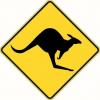If you have one, can you look and see if the iron isn't bedded 8 degrees away from perpendicular to the mouth when viewed frm above please? I think it must be.
I got in a set of 30 degree skew jaws for my LN honing guide, the current Lee Valley website describes the cutting angle as 30 degrees, but the iron I just got in the mail today (Veritas skew rabbet) is ground at 22 degrees from perpendicular to the blade axis.
The simplest explanation is the iron is bedded not perpendicular to the mouth when viewed from above.
I am planning to take all my bits to my machinist Monday, so feel free to kick this around a little bit. I just have too much clock time coming up to get there any sooner.
Option one, looks bad, I could have the edges of the iron reground so that I can use the 30 degree LN jaws, but that is going to a LOT of material off the iron. I would probably have to replace the adjusting screws on the plane body and who knows how well it would function in KD hickory.
Option two, looks expensive and risky, I could have my LN 30 degree jaw set remachined to 22 degrees. They look like they are made out of really good steel, and then I wouldn't have them anymore.
Option three looks like the way to go: Ask my machinist to make a set of 22 degree jaws that could attach to my LN honing guide out of, gosh, 1065 would be fine, and just use those. I would probalby need two sets made of slightly different length, one for the primary bevel and the other longer set for the secondary bevel.
I shall upload pictures before you fall asleep.
20210713_181234[1].jpg20210713_181327[1].jpg20210713_181138[1].jpg20210713_181210[1].jpg
As pictured in the last two pics only the short corner is on the graph paper. The rest of the edge rises off the graph paper - at about 8 degrees. So the penciled bevel angles are just estimates.
The way the iron on my Record 778 is shaped I can use an ecclipse style guide and grind 25 degree primary with the jaws on the narrow upper portion of the blade, and a secondary starting at about 30 degrees (or higher) with the jaws on the wide part of the iron closer to the edge. The tapered or flaring portion of the Veritas iron is a bit more generous than the Record.
The fundamental problem in my shop is space. I have been working too much OT for about five years, with insane clock hours since March 2020, so I have money and not a lot of time, but the biggest problem in my shop is actually space. I can buy all kinds of stuff I don't have room for, I would truly rather, in this season of life, blow a couple hundred on a custom jaw set than make room for another guide.
Anyway, thanks for your comments, this problem is getting solved.




 Reply With Quote
Reply With Quote




